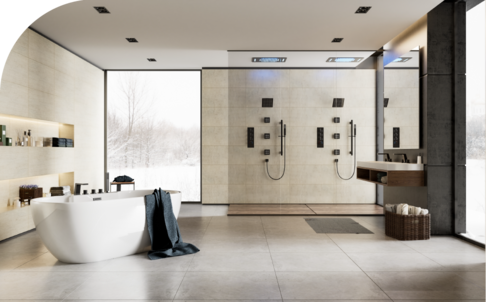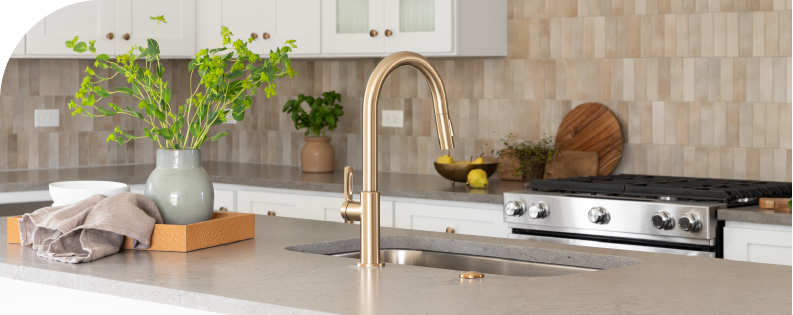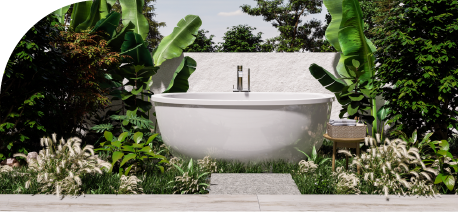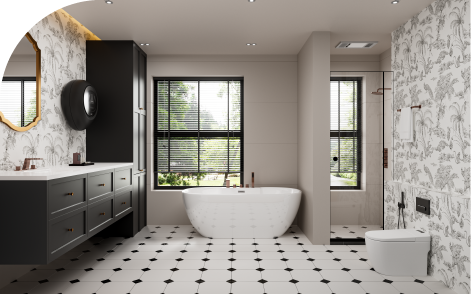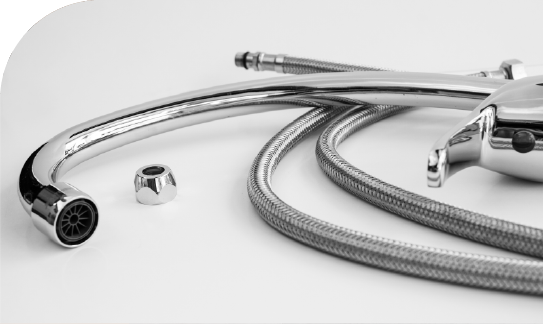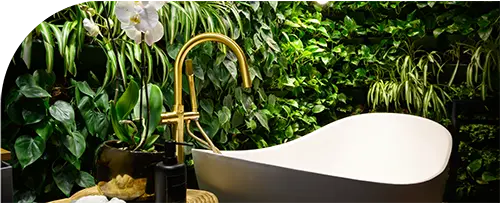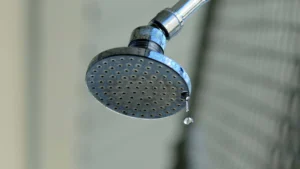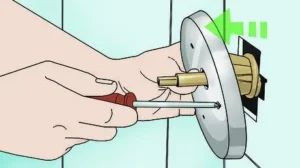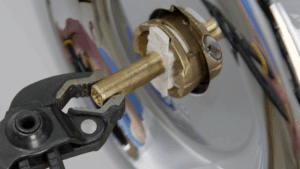A weak shower can absolutely ruin your morning, but the good news is that the fix is often something simple you can tackle yourself. Before you can figure out how to boost that water pressure, you first have to play detective and find the root cause. More often than not, it’s something as straightforward as a clogged shower head, a valve that’s not fully open, or a sneaky little flow restrictor hiding inside.
So, What’s Behind Your Weak Shower Stream?
Before you even think about calling a plumber, a few quick checks can usually tell you exactly why your shower pressure is so disappointing. A weak stream isn’t just an annoyance; it’s a symptom. Pinpointing the real problem is the most critical step toward getting back the powerful shower you deserve.
This infographic breaks down a simple, three-step approach to diagnosing and fixing low water pressure on your own.
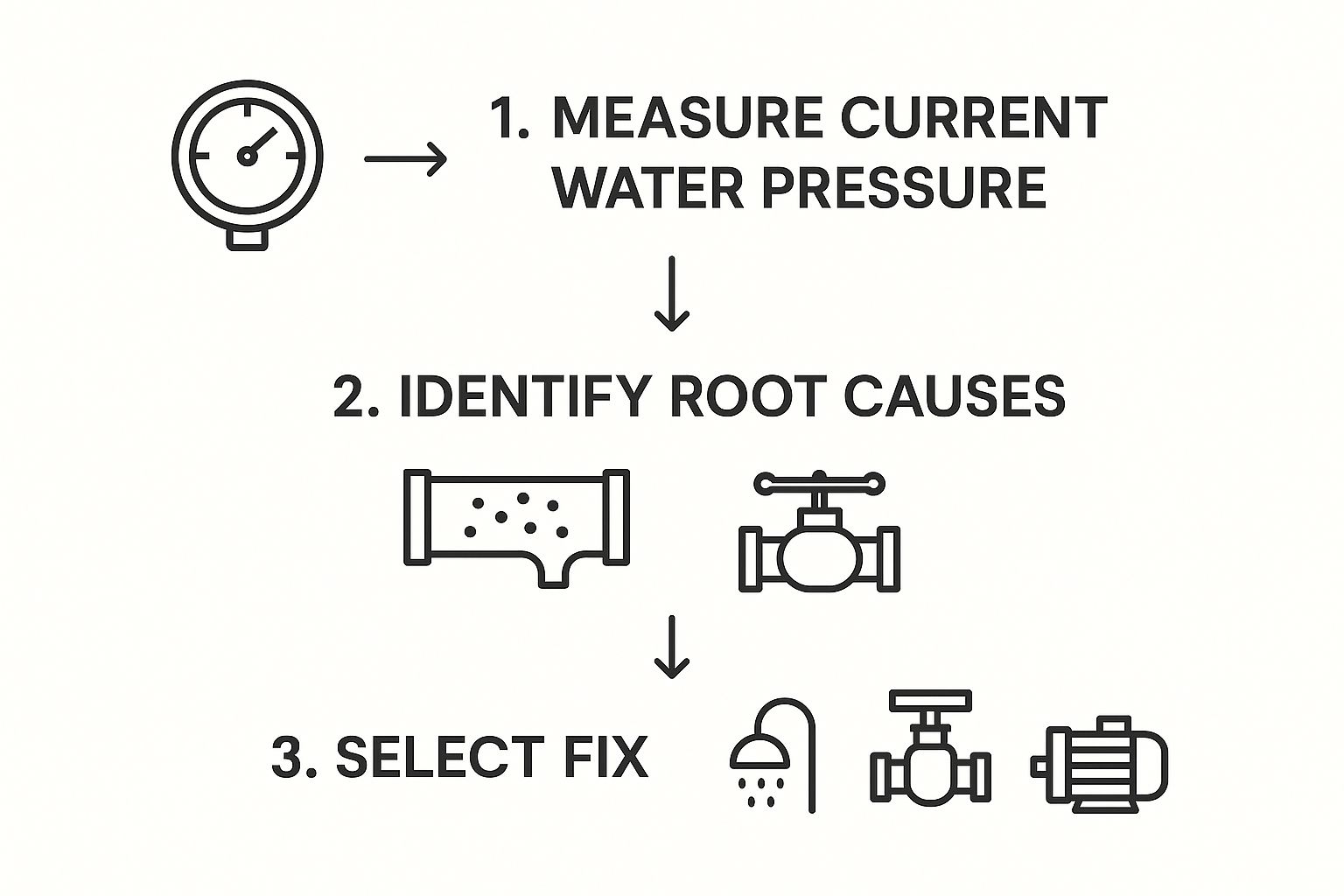
As you can see, the process is logical. You start by measuring the problem, then you identify the cause, and finally, you pick the right solution for your specific situation.
Where Is the Problem Coming From?
Here’s your first big clue: is the low pressure a problem everywhere in your house, or is it just the shower?
Go turn on the faucet in your kitchen sink, then your bathroom sink. If they both have a strong, steady flow while your shower just sort of dribbles, you know the problem is isolated to that one fixture. That’s great news!
But if all your faucets have the same weak, sad flow, the issue is probably affecting the whole house. That could point to your main water valve being partially closed, a problem with the pressure regulator, or maybe even an issue with the municipal water line coming into your property.
To help you get started, here’s a quick cheat sheet for diagnosing what might be going on.
Quick Diagnosis for Low Shower Pressure
| Symptom | Potential Cause | Your First Action |
|---|---|---|
| Only the shower has low pressure | Clogged shower head or flow restrictor | Unscrew the shower head and check for mineral buildup. Clean it out. |
| Both hot and cold water are weak | A single-handle mixing valve might be clogged or failing | Check other fixtures. If they are fine, focus on the shower’s valve. |
| Only the hot water is weak | Sediment buildup in your water heater or a failing valve | Flush your water heater (if you know how) or inspect the hot water shut-off valve. |
| All fixtures in the house are weak | Main shut-off valve isn’t fully open or a failing pressure regulator | Locate your main water shut-off valve and ensure it’s completely open. |
This table should give you a solid starting point. By matching your symptoms to the likely cause, you can take the right first step without wasting time on fixes that won’t help.
The Growing Demand for Better Showers
It seems nobody wants to put up with a bad shower anymore. The desire for a more powerful, spa-like experience has kicked off some serious growth in the market.
In fact, the market for products designed to improve shower pressure is expected to jump from $5 billion in 2025 to a massive $8.5 billion by 2033. This surge shows just how much people are willing to invest in better-performing fixtures. If you’re curious, you can find more insights on this growing market and see just how big the trend is.
Simple DIY Fixes You Can Do Right Now
If you’ve figured out the pressure problem is just in your shower, you’re in luck. The most common issues are surprisingly simple to handle yourself, and you probably won’t even need to call a plumber.
Let’s start with the most likely suspect: a clogged shower head.
Over time, mineral deposits from your water—especially if you have hard water—build up inside the tiny nozzles. This limescale physically blocks the water from flowing freely, turning what should be a strong, satisfying spray into a weak, sputtering trickle.
The best solution is a good, deep clean. A simple vinegar soak works wonders at dissolving that stubborn buildup. We walk you through the entire process in our guide on how to clean a shower head with vinegar. Honestly, this one trick can often get your pressure back to normal in less than an hour.
The Hidden Flow Restrictor
So, you gave the shower head a thorough cleaning and the pressure is still disappointing? There’s another common culprit that could be hiding inside: the flow restrictor.
This is a small plastic or rubber disc that manufacturers install to meet water conservation standards, usually capping the flow at 2.5 gallons per minute (GPM) or less.
While these devices are great for saving water, they can make your shower feel disappointingly weak, particularly if your home’s water pressure is low to begin with. Removing it is a popular DIY fix for an instant pressure boost.
Important Takeaway: Taking out the flow restrictor is generally safe for your plumbing. Just remember, it will increase your water usage, which means you’ll see a bump in your water and energy bills.
Finding it is easy. First, unscrew your shower head from the pipe it’s attached to (the shower arm). Peek inside the part that connects to the pipe. The flow restrictor often looks like a small mesh screen or a simple O-ring with a tiny hole in the center.
You can usually pry it out with a small flathead screwdriver or even a straightened paperclip. Once it’s out, screw the shower head back on, turn on the water, and see the difference for yourself.
Check Your Home’s Water Valves
If a deep clean didn’t do the trick and your shower still feels weak, it’s time to play detective with your home’s water valves. It’s a surprisingly common culprit. A valve that’s been left partially closed can act like a roadblock for your water, and it’s an easy fix you might have overlooked.
Start with the valve dedicated just to your shower. You can usually find this behind a small access panel, often in a closet backing onto the shower wall or tucked away under a nearby sink. You might see a single handle for both hot and cold, or sometimes separate valves for each.
Your mission is to make sure they are turned all the way open. That means rotating them completely counter-clockwise. You’d be surprised how often these get nudged partway closed during a repair and never fully reopened, strangling the flow to your showerhead. If you have a more complex mixing valve inside the wall, you can dig into the specifics with our guide on shower valve rough-in dimensions for the technical side of things.
Inspecting the Main Supply and Regulator
Still no luck? Let’s broaden the search to your home’s main water shut-off. This is the big one, controlling water to the entire house. It’s almost always located right where the main water line enters your home—check the basement, a utility closet, or near your water heater. Just like the shower valve, you want to confirm it’s fully open.
Pro Tip: A “gate valve” looks like a round knob and needs to be turned fully counter-clockwise. A “ball valve” has a lever handle; it’s open when the handle is running parallel with the pipe.
While you’re at it, look for a pressure regulator. It’s a bell-shaped device that protects your pipes from excessively high pressure coming from the city’s supply. If this little gadget fails, it can get stuck in a low-pressure setting. While some are adjustable, a faulty regulator is often a job for a professional to replace to get your water flowing properly again.
Upgrade to a High-Pressure Shower Head
Sometimes, the simplest fix is the most satisfying one. If you’ve already cleaned out your current fixture and checked the shut-off valve but your shower still feels weak, it might be time to upgrade your hardware. Swapping out that old, tired unit for a modern high-pressure shower head can completely change your daily routine.
In many homes, this is the most direct path to figuring out how to increase the pressure of water in your shower.
These fixtures don’t magically pull more water from your pipes. It’s all about smart engineering. They’re designed to make the water you already have feel much, much stronger, optimizing the output for a far better experience.
How High-Pressure Heads Work
The secret is all in the design. Most high-pressure models work by channeling the same amount of water through much smaller, precision-engineered nozzles. This forces the water out at a higher velocity, creating a spray that feels incredibly strong and invigorating. It’s the same idea as putting your thumb over the end of a garden hose—you’re not using more water, but the stream becomes way more intense.
Another brilliant approach you’ll see is air-induction technology. These shower heads have tiny openings that pull surrounding air into the water stream. This infuses each water droplet with air, making them feel bigger, fuller, and heavier. The result is the sensation of a powerful, drenching downpour, even if your home’s actual water pressure is just so-so.
There’s a reason this market is booming. The global high-pressure shower heads market was valued at around $2.7 billion in 2023 and is expected to hit $4.5 billion by 2032. That’s a clear signal that people everywhere are seeking a better shower experience.
Exploring Your Upgrade Options
When you start looking around, you’ll notice a few different kinds of high-pressure heads, each built to deliver a unique kind of shower.
- Powerful Spray Models: Think of these as the workhorses. They’re all about creating high-velocity streams that are fantastic for rinsing shampoo out of thick hair or giving you that powerful blast to wake you up in the morning.
- Innovative Turbo-Fan Designs: These are a newer and really interesting option. They use a small internal fan, powered by the water flow itself, to pressurize the water before it sprays out. This often creates unique, swirling patterns and does an amazing job of turning even a weak trickle into a full-body spray.
Upgrading your shower head is often a quick, reliable, and highly effective way to solve low-pressure woes. For other potential fixes, take a look at our complete guide on how to increase shower water pressure.
So, you’ve done everything you can think of. You cleaned the shower head, made sure all the valves were wide open, and even tried a brand-new fixture. But your shower still feels more like a sad trickle than a powerful stream.
When the simple fixes don’t make a dent, it’s usually a sign that the problem runs deeper than the shower itself. It’s time to start looking at the bigger picture—your home’s entire water system.
Persistent low pressure across your home often points to an issue that no amount of fixture swapping will solve. This is especially common in older homes with gravity-fed systems, where low water pressure is just a fact of life. In these situations, your water needs a serious push to get where it’s going.
When It’s Time for a Pressure Boost
If the weak flow isn’t just in your shower but at every faucet, you’re looking at a whole-house problem. Luckily, there are a couple of heavy-hitting solutions: a shower pump or a whole-house pressure booster.
- Shower Pump: This is your targeted solution. A shower pump is installed to boost water pressure for a single shower or an entire bathroom. It’s the perfect choice if the low pressure is isolated to one area and you don’t want to overhaul your home’s entire plumbing system. It works by grabbing the existing water flow and actively forcing it through the shower head with much more power.
- Whole-House Pressure Booster: If a weak stream plagues every sink and appliance in your home, this is the comprehensive fix you need. Installed right on your main water line, this system cranks up the pressure for the entire property. Your shower will be amazing, but so will your kitchen sink and washing machine.
Key Insight: The choice really comes down to scope. A whole-house booster solves the problem everywhere, but a shower pump is a more targeted—and often more affordable—fix for that one frustrating bathroom.
Keep in mind, these aren’t simple DIY projects. Both a pump and a booster system require a professional plumber to install correctly. The costs can vary quite a bit depending on the unit you choose and how complex your home’s plumbing is, but it’s a surefire way to finally put an end to chronic low-pressure woes.
While you’re already thinking about bigger plumbing jobs, it might be a good time to learn how to replace a bathroom faucet to give your space a full refresh.
One last thing to consider is the age and material of your pipes. If your home has old, galvanized steel pipes, they can corrode from the inside out over decades. This corrosion builds up and can choke off your water flow. If you’re also seeing discolored water or your fixtures are clogging up all the time, it’s probably time to have a plumber come take a look.
Your Shower Pressure Questions, Answered
Even after trying a few fixes, you probably still have some questions floating around. I get it. Tinkering with your home’s plumbing can feel like a big deal, and it’s smart to get all the facts before you dive in. Let’s clear up some of the most common things people ask when they’re trying to boost their shower pressure.
Will a High-Pressure Shower Head Jack Up My Water Bill?
This is the number one worry I hear, and the answer is almost always no. It seems counterintuitive, right? But modern high-pressure shower heads are designed to be incredibly efficient. They use clever tricks like air-infusion technology or smaller, pressurized nozzles to make the water feel much stronger, but without actually using more of it.
In fact, many of today’s water-saving models have brought flow rates down from an older standard of 12 liters per minute to as low as 7.4 liters per minute. They’re engineered to give you that powerful spray you want while saving water.
Is It Really Safe to Pop Out the Water Restrictor?
Yes, from a plumbing perspective, removing the flow restrictor is perfectly safe. It’s a very common DIY fix that won’t cause any damage to your pipes or the shower head itself.
But here’s the trade-off: The main impact is on your wallet and the environment. Taking that little plastic disc out means you will use significantly more water, and more energy to heat that water. Your utility bills will go up. It’s a simple choice between a more powerful shower and higher monthly costs.
How Do I Know if It’s Just My Shower or a Whole-House Problem?
This one’s easy to figure out. Just walk around your house and test the other faucets. Turn on the taps in your kitchen and bathroom sinks and let them run at full blast.
- If the flow is weak everywhere, you’re looking at a whole-house issue. The culprit is likely the main water shut-off valve, a faulty pressure regulator, or even an issue with the water supply coming from the city.
- If it’s only the shower that’s dribbling, then the problem is isolated right there. It’s something specific to the shower head, the valve behind the handle, or the pipe leading to it.
For a deeper dive into other common issues, you can always check out our full list of frequently asked questions for more troubleshooting tips.
Ready to transform your daily routine with a powerful, clean shower? At Cranach, we believe everyone deserves a healthy and invigorating shower experience. Explore our premium collection of high-efficiency shower systems and faucets designed for superior performance at https://cranachhome.com.

